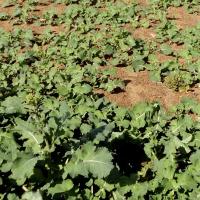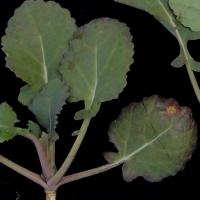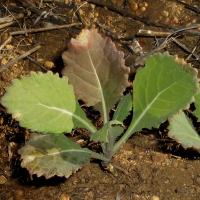Diagnosing phosphorus deficiency in canola
Nearly all soils in WA were phosphorus deficient but continual use of phosphorus fertiliser means acute deficiency in broadacre crops is rare, with the exception of Darling Range gravels. Phosphorus deficiency is often transitory and compounded by dry soil with symptoms disappearing when topsoil is re-wet following rainfall.
What to look for
- Smaller less branched plants with worse symptoms on higher phosphorus fixing and acidic soils, and in very dry seasons.
Paddock
- Deficiency most commonly shows as smaller plants with similar shaped leaves.
- From stem elongation the main stem is thinner and branching is restricted.
- Flowering time and pod numbers are reduced.
- Severely deficient plants develop a narrow purple margin of the leaf blade that spreads inwards.
- The leaf turns bronze before dying.
Plant
What else could it be
| Condition | Similarities | Differences |
|---|---|---|
| Turnip yellows virus in canola: diagnosis, epidemiology and management | Purple-red colours on oldest leaves | However purpling spreads down from the leaf end with beet western yellow virus and affected plants are stunted rather than smaller and thinner. Phosphorus deficient plants will vary with the soil type. |
| Diagnosing nitrogen deficiency in canola | Purple-red colours on oldest leaves | However nitrogen deficient plants symptoms move from the margins to the base with the leaves turning yellow or pink/purple. |
Where does it occur?

Soil type
- Phosphorus deficiency is a problem on high phosphorus-retaining soils,particularly in the Darling Range where soil acidity and water repellence markedly reduce phosphorus uptake.
- Dry topsoil can lead to temporary phosphorus deficiency on all soils particularly during early crop growth and on water repellent soils.
- Water repellent and acidic soils require more phosphorus.
Management strategies
- Plants have a high requirement for phosphorus during early growth. As phosphorus is relatively immobile in the soil, topdressed or sprayed fertiliser cannot supply enough to correct a deficiency.
- Phosphorus is poorly mobile in most soils, but does move on very low PBI sands, particularly on coastal plains. Topdressing is effective on these soils, but deficiency is rare.
- Root pruning by aluminium toxicity on acidic soils markedly increases phosphorus deficiency.
How can it be monitored?

Soil test

Tissue test
- Soil test to determine phosphorus fertiliser requirements. Soil tests may underestimate available phosphorus on very low PBI sands and overestimate it on acidic and water repellent soils (particularly in the Darling Range).
- Use whole-top plant test to diagnose suspected phosphorus deficiency, and compare paired good/poor plant samples where possible.
- Critical plant phosphorus levels vary with plant age and size, but as a rough guide 0.3 per cent (seedling) to 0.25 per cent (rosette) indicate deficiency.
See also
Further information
Where to go for expert help
Page last updated: Wednesday, 6 May 2015 - 11:30am




